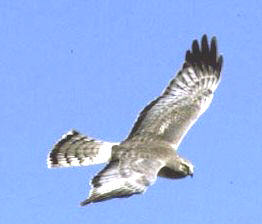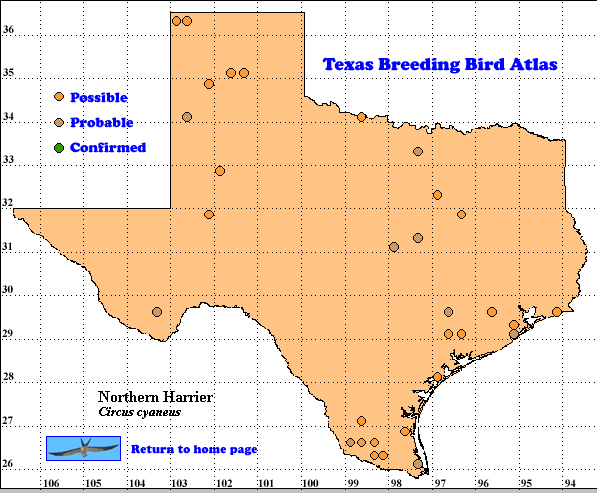The “quartering” flight of a pearl-gray male Northern Harrier, low over a field, is always a special treat for bird-lovers. Although this hawk can be easily seen foraging, finding confirmed breeding evidence is not easy. In Colorado and Oklahoma 7% of observations were confirmed (Carter 1998, Smith 2004),while in Arizona (Wise-Gervais 2005) and Texas, no observations were confirmed..
DISTRIBUTION. During the 1987-1992 field work seasons of the TBBA project, observers found 9 probable and 30 possible. but no confirmed breeding sites. Most sites were located on the High Plains, Coastal Prairies and Coastal Sand Plain with some sites west of the Pineywoods (see the region map in Lockwood and Freeman [2004]). The TBBA evidence is consistent with these authors’ characterization of Northern Harrier as a rare summer visitor and even rarer breeder.
Outside Texas Northern Harriers breed from Alaska across Canada to the northeastern United States. The species also breeds from the Continental Divide in Montana to the northern Great Laked states and locally further south. In winter harriers from Alaska, Canada and New England move south. The winter range extends through Mexico to Central America and also the northern Caribbean. Another form in the Old World is currently considered conspecific with Northern Harrier. (Howell and Webb 1995, MacWhirter and Bildstein 1996Am. Ornithol. Union `998).
SEASONAL OCCURRENCE. Northern Harriers are most easily seen in Texas from late August to mid-October and early April to mid-May when migrants are common. Breeding occurs from April to late July (Oberholser 1974, Lockwood and Freeman 2004).
BREEDING HABITAT. Northern Harriers breed in Texas from sea level to 1350 m (4500 ft) in open, treeless country (Oberholser 1974). The Oklahoma BBA describes the habitats of this hawk as open grasslands, wetlands, marshes, pastures, old fields and dry upland prairies (Smith 2004) and in Colorado almost all breeding evidence was found in grassland, shrubland or riparian habitats (Carter 1998).
The nest, built by the female while the male gather materials, is comprised of sticks, straw and grasses. The structure is placed on or near the ground. The outside diameter is 38-76 cm (15-30 in), inside diameter 20-23 cm (8-9 in) and cup depth 5-10 cm (2-4 in ; Harrison 1979, MacWhirter and Bildstein 1996).
The female usually lays 4-5 smooth, unmarked white eggs on alternate days. She begins incubating after laying the first egg, and the young begin hatching sequentially 28-36 days later. The young begin flying about 29-32 days after hatching. Some males have as many as 5 mates (MacWhirter and Bildstein 1996).
STATUS. Northern Harriers are rare in Texas in summer (Lockwood and Freeman 2004) and Breeding Bird Survey data from 10 routes in Texas suggest an annual population change of -1.8% for the period 1980-2005. This trend is similar to the statistically significant -1.2% trend from 957 routes across the United Stated and Canada (Sauer et al. 2005).
Text by Robert C. Tweit (2007)
Literature cited.
American Ornithologists’ Union. 1998. Checklist of North American birds, 7thed. Am, Ornithol. Union, Washington, DC.Carter, M. F. 1998. Northern Harrier (Circus cyaneus). In Colorado Breeding Bird Atlas, pp. 110-111 (H. E. Kingery, ed.), Colorado Bird Atlas Partnership, Denver.
Harrison, H. H. 1979. A field guide to western birds’ nests. Houghton Mifflin, Boston, MA.
Howell, S. N. G. and S. Webb. 1995. A guide to the birds of Mexico and northern Central America. Oxford University Press, New York.
Lockwood, M. W. and B. Freeman. 2004. The TOS handbook of Texas birds. Texas A&M University Press, College Station.
MacWhirter, R. B. and K. L. Bildstein 1996. Northern Harrier (Circus cyaneus). InThe Birds of North America, No. 210 (A. Poole and F. Gill, eds.). The Birds of North America, Inc., Philadelphia, PA.
Oberholser, H. C. 1974. The bird life of Texas, University of Texas Press, Austin.
Sauer, J. R., J. E. Hines, and J. Fallon. 2005. The North American Breeding Bird Survey, results and analysis 1966-2005. Version 6.2 2006. USGS Patuxent Wildlife Research Center, Laurel MD < http://www.mbr-pwrc.usgs.gov/bbs>
Smith, G. A. 2004. Northern Harrier (Circus cyaneus). In Oklahoma Breeding Bird Atlas, pp. 93-93 (D. L. Reinking, ed.). University of Oklahoma Press, Norman.
Wise-Gervais, C.. 2005. Northern Harrier (Circus cyaneus). In Arizona Breeding Bird Atlas. pp. 128-129 (T. E. Corman and C. Wise-Gervais, eds.), University of New Mexico Press, Albuquerque.

